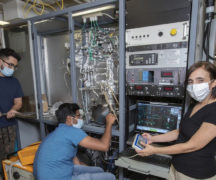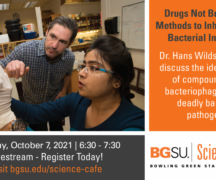By DAVID DUPONT
BG Independent News
Maybe algae gets a bad rap.
The broad category of aquatic organisms is mostly associated in the area with harmful algae blooms (HAB) that appear in Lake Erie every summer, and most disastrously resulted in the shutdown of water systems throughout the region during the Toledo Water Crisis in August 2014.
Chris Ward, of the Bowling Green State University faculty, said people have come to think algae “is inherently bad.”
And his colleagues in the Center for Great Lakes and Watershed Studies, are working to mitigate those harmful effects.
Ward meanwhile is studying how to improve the way algae is grown, specifically how to control the parasites that destroy it.
Recently Ward presented his research during a virtual Science Café program “Algae’s Upside.”
Algae is neither good nor bad, the biologist said. Algae just an organism that has evolved to grow in the water with sunlight and CO2.
Nutrients, such as agricultural runoff, foster algal growth to deleterious results in Lake Erie and water bodies around the globe. But harmful algae blooms, he noted, can occur naturally as well.
Algae absorbs CO2 and releases oxygen – about 50 percent of the oxygen we breathe, he said.
Ward noted that algae –aquatic organisms that use photosynthesis – are the foundation of aquatic food webs.
And forms of the organism have fed humans for thousands of years. Both directly as food and indirectly as fertilizer.
They still play an important part in the human diet, and not just as wrappers for sushi.
Seaweed is used to make thickeners and other additives that are common in foods, as well as a component in personal care products and cosmetics.
NASA is studying how to grow algae as a possible food source for space explorers. It would be essential for a mission to Mars, not just for nutrition, but also because the algae beds would absorb CO2
Ward also noted that algae contains oils, which when extracted can serve as a biofuel.
While that work is well underway, both for auto and jet fuel, to date the fuel produced is more expensive than traditional sources. Right now the estimate is that biofuel produced by algae would cost $4 a gallon. By 2030, that could be down to something between $2.30 and $2.50 a gallon.
Regardless of how it is used, “algae cultivation remains the most difficult and costly part of the whole process,” Ward said. He admitted the irony, given the concerns about the ample harmful algae blooms in Lake Erie each summer.
But growing algae for commercial uses is best done in engineered systems that can be contained and controlled. These can either be in ponds on land or in enclosures in bodies of water.
Ward’s research is looking at how to deter a parasite that can kill an entire pond of algae. He and research assistant Fiona Harrigian are looking at what factors cause this destruction, which doesn’t always happen, and whether some strains of algae are more susceptible.
The goal is to mitigate these pests, he said.
Ward says his dream is to use engineered systems to reduce the nutrients going into Lake Erie and other bodies of water to prevent the growth of harmful algae.
Nutrients from a variety of sources, including farms and breweries, can be introduced into the systems. The nutrients feed the algae.
The algae cultivated in these systems then can be turned into commercial products – fertilizer, fish food, fuel or other uses.
This both mitigates the algae growth in Lake Erie, and produces commercial products.
When asked, Ward noted that the harmful algae that grows in Lake Erie is not suitable for fuel productions, as well as being harder to harvest than the algae grown in engineered systems. “HABs don’t produce enough algae for biofuels.”
Ward is looking for some help from the upcoming generation of scientists. At the request of a student at the high school alma mater in Baltimore, he developed an algae growing system using a canning jar and other material available at a hardware store and pet supply shop.
These can be set up in a basement or classroom, and experiments can be done on a variety of essential questions about algae farming.
He said any teacher interested in such a project should reach out to him at chrward@bgsu.edu.
***
The next BGSU Science Café will be “Linking Watersheds and Wetlands to Lake Fisheries” livestreamed Thursday, March 25, 2021 6-8 p.m. Dr. Jeff Miner, a professor in BGSU’s Department of Biological Sciences, will discuss environmental connections between water and habitat quality on fisheries in western Lake Erie, focusing on Sandusky Bay habitat restoration efforts.





